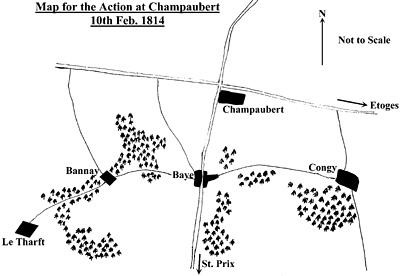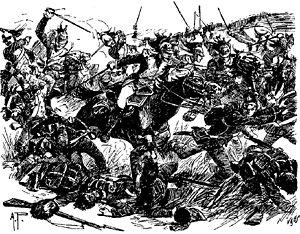The Action of Champaubert
1814
by Patrick E. Wilson, UK.
| |
The Action of Champaubert itself is relatively small and can easily be re-fought on the wargames tabletop, the Russians having about 4,000 men, the French about 10,000 men. The Action involves the defence of villages and woods, and an attempt to withdraw (belatedly) when faced by superior numbers. It offers a real challenge to the Russian player and should turn out to be a good wargame.
The French forces primarily involved in this action were Marechal Auguste Marmont's 6th Corps d'Armee and General Bordesoulle's 1st Cavalry Corps. These forces, as far as I can ascertain at present, were composed of the following: Marmont's Corps had two infantry divisions, General Ricard's 8th division (composed of the remnants of the 8th, 9th and 11th infantry divisions, formerly of the 3rd Corps d'Armee of the 1813 campaign) of 14 small battalion, mostly cohort formations of the previous year, and 12 guns. General Lagrange's 21st division (composed of the remnants of the 20th, 21st and 22nd infantry divisions of the 6th Corps d'Armee of the 1813 campaign) which included the famous Marine infantry regiments of the previous year plus artillery. Bordesoulle's Cavalry Corps, the remnants of the 1st Cavalry Corps of 1813, General Chastel's 3rd Light Cavalry Division, for example, numbered only 337 officers and men when that General crossed the Rhine in November 1813. By February 1814 Bordesoulle had about 3,000 cavalrymen, including Chasseurs a cheval, Dragoons and Cuirassiers.
Marmont and Bordesoulle combined, counting losses incurred at La Rothiere, had about 10,000 men, twice the number available to Olsuview and these were backed up by Napoleon with another 20,000 men.
General Olsuview, according to General Poltoratzki, one of his brigade commanders, only had 3,690 men and 24 guns (2X12 gun batteries). This represented the total strength of the Russian 9th Corps, which consisted of two infantry divisions (the 9th and 15th infantry divisions) of three brigades each. These brigades had two regiments apiece, though probably they only had one very much reduced battalion to represent them. Olsuview's men had been in action at both Brienne and La Rothiere and had suffered accordingly, their formations reminiscent of Napoleon's skeletal forces at the Battle of the Berezina in 1812. They were certainly too weak to face forces double their size and commanded by one of Napoleon's most skilled Marechals.
The town of Champaubert is situated a little to the South of the Chalons to Meaux highway. The main theatre of action was to the South and South-west of this town. The town of Baye and some adjacent woods lay immediately to the South of Champaubert, the village of Bannay and more woods lay to the Southwest. A road ran from Champaubert through Baye to the village of St. Prix, where there was a bridge over the river Morin. it was over this river that Napoleon's forces would arrive. Olsuview had decided nut to destroy this bridge as he intended to use it himself to march on Sezanne, unfortunately he had also neglected to guard or secure it against French attack. For this he undoubtedly needs to be criticised but then again he may have believed, like so many others, that the French had been shattered at La Rothiere and he would only have mopping up operations to undertake as he moved to support Schwarzenberg's operations on the Seine.
Weather
A special note ought to be made of the weather here, throughout the entire campaign of 1814 it was alternatively freezing and thawing. The 1St February (the Battle of La Rothiere) had seen heavy snow showers but by the 10th February it had been raining for five consecutive days, this had resulted in the majority of roads being turned into quagmires and the near impossibility of moving artillery. The men on both sides would have suffered from nut only cold and fatigue but hunger as well, the Russians would have also began to feel the effects of an increasingly hostile populace. Any wargame would need to take into account these weather factors, cavalry and artillery movement should be slower then usual, fire factors would also be effected.
On the 9th February Polish Lancers appeared at St. Prix and advanced against the town of Baye but were driven off by Olsuview's men, eventually they retiring back over the Petit Morin river via St. Prix. This event should have had the alarm bells ringing at Olsuview's headquarters and his own commander - in-chief's but the mere fact that these enemy lancers had withdrawn seemed to allay nearly everyone's suspicions. Although, von Muffling fur instance, wanted to send General Sacken to support Olsuview at Champaubert but was over ruled by General August Gniesenau, Field-Marshal von Blucher's chief-of-Staff. General Olsuview himself, because of the reprimand he had received for his supposed failure at Brienne, refused to retreat to a safer position at Etoges when urged to do so by several of his own subordinates. It was an error that would cost him dearly but perhaps very understandable, since his honour had been brought into question in a era when this was of immense importance,
The 10th February saw the return of the French, who quickly re-established themselves as masters of the bridge at St. Prix but did nut attack Olsuview's forces until noon. By which time Olsuview had ordered General Udom and his 9th division forward to hold the town of Baye. The first enemy forces that Udom encountered were the Empress Dragoons and these supported by their comrades soon forced the Russian General and his regiments back into Baye and its adjacent woods. This cavalry was quickly replaced by General Ricard and his 8th Infantry division, who soon advanced against Udom's positions around Baye whilst another division, General Lagrange and his 21st Infantry division, advanced on Ricard's left and attempted to turn Udom's right. Olsuview reinforced Udom with another brigade and the village of Bannay to Udom's right was occupied. The French attempt to take Bannay and outflank Udom was defeated by this manoeuvre. Udom was thus able to successfully hold two French divisions hut sadly not for long as Marechal Michel Ney now advanced to support his colleague Marechal Auguste Marmont. These two officers, assured of both artillery superiority and numbers, and after the most ferocious fighting, finally ejected General Udom and his gallant soldiers from both Baye and Bannay at about 3.00pm. At the same time the French cavalry, until now mere spectators to the fighting in the villages and woods, now came forward to cut off and destroy the remnants of Udom's regiments.
General Olsuview had now decided to retreat, ordering General Poltoratzki with his brigade and a number of guns to defend Champaubert to the last. Whilst, he and the rest of his Corps d'Armee, basically the troops that had been fighting under Udom at Baye and Bannay, attempted to retreat via the woods for Etoges. Where it was hoped they would receive support from Generals von Kliest and Kapzewitch, who were known to be marching on that place. Unfortunately, Olsuview did nut make it, being captured with part of his command in the woods by newly joined conscripts in their early teens- a great blow to his self esteem no doubt! However, the gallant Udom and about 1,100 men, together with 15 guns did successfully reach Etoges that night. Poltoratzki meanwhile defended himself with great bravery, resisting attacks by both cavalry and infantry until his ammunition was exhausted and he was totally surrounded. He then surrendered with about 1,000 men and 9 guns.
The action of Champaubert was over, Olsuview had been utterly defeated and his Corps scattered, General Udom only rallying the remnants that evening at Etoges. Over 2,000 men had been killed, wounded or captured, French losses were a few hundred! Olsuview's wounded pride had given Napoleon an easy victory and destroyed the Russian 9th Infantry corps to little purpose.
The action of Champaubert is ideal for a wargame, the number of troops involved is relatively small, the objectives of each are clear and the terrain has the potential to provide the wargamer with both an interesting scenario and a challenging game. The Russian player/players require only 12 under strength battalions/regiments and 2X12 gun batteries. The French player/players require 2-3 under strength divisions (one should be of young Guardsmen) and perhaps 2 under strength cavalry divisions with appropriate artillery batteries. The total French strength should equal about 15,000 men. The French should also arrive on the tabletop one by one with the cavalry leading, although the French order of march ought to be kept secret from the Russian player/players, who should only response to what they can actually see on the tabletop. The Russians could also be given agreed number of hours to defend their positions before attempting any retreat. These conditions should allow a good game to develop and test the skill of the players, perhaps allowing the Russians to gain some local victory before being overwhelmed or compelled to retreat. The exact mechanics of the game should be agreed by the wargamers prior to the commencement of the game, an independent umpire would be useful and would be in a position to solve any disputes that may arise. The must important thing though, is that Olsuview makes a determined attempt to stand and defend himself around the villages of Bannay and Baye. This is essential to the game.
My primary source for these has been Peter Hofschroer's Osprey Book on the Battle of Leipzig hacked by bits of information gleaned from here and there.
6th Corps d'Armee: Marechal Auguste Marmont (approx. 10,000 men plus artillery)
1st Cavalry Corps: General Bordesoulle (approx. 3,000 men plus artillery)
Young Guard Corps: Marechal Michel Ney (approx. 6,000 men plus artillery).
9th Russian Corps d'Armee: General Olsuview
15th Division: General Kornilov
Artillery:
Chandler, David G., The Campaigns of Napoleon (New York: Macmillian, 1966, Reprint London: Weidenfeld & Nicolson, 1987).
 Back to Table of Contents -- First Empire #46 Back to First Empire List of Issues Back to MagWeb Master Magazine List © Copyright 1999 by First Empire. This article appears in MagWeb (Magazine Web) on the Internet World Wide Web. Other military history articles and gaming articles are available at http://www.magweb.com |
 The Russian General Olsuview (Commander of the 9th Russian Infantry Corps) received a bitter reprimand fur his performance at the Battle of Brienne in January 1814. His immediate superior, General Baron Sacken, accused him of failing to secure all the avenues of approach into Brienne and as result the French had got into Brienne and the Russians had lost the Battle. Sacken himself had nearly been captured during the fight and this no doubt contributed to the fury with which Sacken berated Olsuview. Unfortunately this would have an unforeseen effect upon Olsuview only a few days later, when that general was faced with the difficult decision of having to withdraw or fight when confronted by a superior enemy force. Olsuview's decision, wrong as it turned out, led to the Action of Champaubert and the destruction of his Corps by Napoleon's troops.
The Russian General Olsuview (Commander of the 9th Russian Infantry Corps) received a bitter reprimand fur his performance at the Battle of Brienne in January 1814. His immediate superior, General Baron Sacken, accused him of failing to secure all the avenues of approach into Brienne and as result the French had got into Brienne and the Russians had lost the Battle. Sacken himself had nearly been captured during the fight and this no doubt contributed to the fury with which Sacken berated Olsuview. Unfortunately this would have an unforeseen effect upon Olsuview only a few days later, when that general was faced with the difficult decision of having to withdraw or fight when confronted by a superior enemy force. Olsuview's decision, wrong as it turned out, led to the Action of Champaubert and the destruction of his Corps by Napoleon's troops.